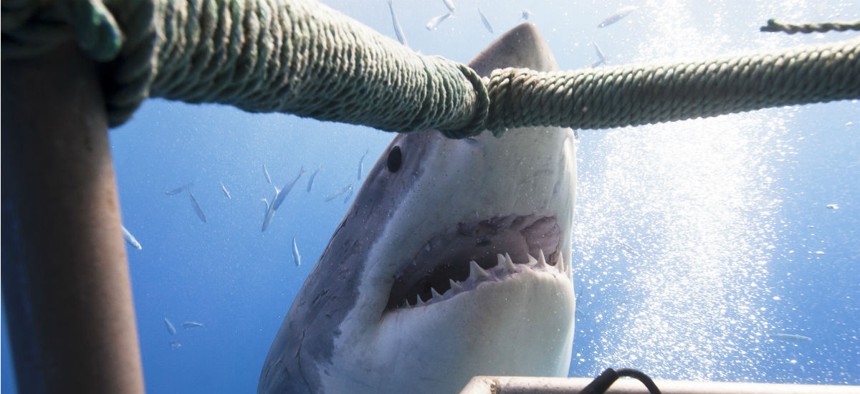Three Leadership Rules for the Shark Cage
Even if your team doesn’t face physical danger, things can get pretty rough out there.
If you haven’t already seen it, watch this video of a great white shark attacking a dive cage. It runs about a minute and a half and is straight out of Jaws.
OK, now that you’ve watched it, we need to draw some leadership lessons from what happened there. (Great thanks and props to my client Brian Schools who CC’d me on an email he sent to his leadership team at Chartway Federal Credit Union in which he shared the video and some similar lessons.) Since no one got eaten by a shark, we can, with a clean conscience, break the video down into some takeaways for team leadership. You may or may not be leading a team in a physically dangerous situation, but no matter the circumstances, it can get pretty rough out there. So, based on a true story, here are some leadership rules for the shark cage.
Know who’s in the cage. We hear a lot in team settings about having each other’s backs. As the shark cage video demonstrates, you can’t protect somebody else’s back if you don’t even know where their back is.
Here’s the breakdown on the conversation around the cage after the shark burst through the top of it and swam away.
First person: “Is there anybody in there?”
Second person: “Nobody’s in the cage.”
First person: “Nobody’s in the cage?”
Third person: “Somebody’s in the cage.”
Another person: “Oh my God.”
Yeah, OMG. The first leadership rule for the shark cage is to know who’s in the cage. If you’re the team leader, your first responsibility is to know where your team members are—literally and figuratively—and what they’re up against. On a truly high performing team, each team member can answer those questions for every other team member.
Be prepared for the unexpected. You’d think that in an activity as dangerous as shark cage diving, everyone on the team would be prepared for the expected or unexpected. Like, what happens if the shark breaks through the cage?
Several years ago, I had the opportunity to spend a weekend in the Florida Straits with the crew of the U.S. Coast Guard cutter, the Venturous. As I wrote here after that trip, there were many things that impressed me, but the biggest was how much time and effort went into preparing for emergencies. As soon as we left port, the crew started practicing man overboard drills. The next morning it was a migrant interdiction drill. Good thing they practiced because that very afternoon, they had to pick up a raft full of migrants.
In business, you can’t always run drills for everything that might come up, but you can at least get in the habit of asking, “What if?” on a regular basis. What would we do if this happened? What’s our best option if that happens? By engaging your team in thinking through the possibilities and how they’d respond you can help everyone prepare to perform at their best when the unexpected happens. Prepare for the unexpected. That’s the second leadership rule for the shark cage.
Offer meaningful support. When things get rough, you need to offer your team members meaningful support. That’s the third leadership rule for the shark cage.
How would you feel if you were the person crawling out of the cage after the most frightening experience of your life and all you get are some weak sauce questions like “Are you OK?” and “You’re not hurt, right?” along with a pat on the back. No one even said, “Dude, I’m sorry you almost got eaten by a shark,” let alone doing some sort of physical check to make sure the diver wasn’t injured or about to go into shock. That would have been some meaningful support.
What kind of meaningful support does your team need when it’s in rough waters? If you were them, what would you want?








